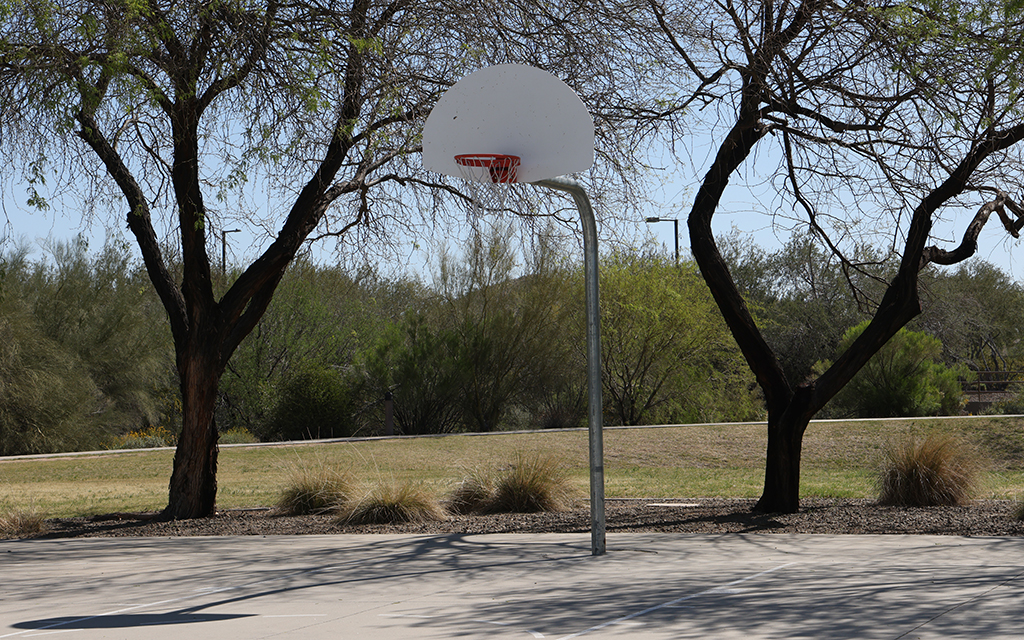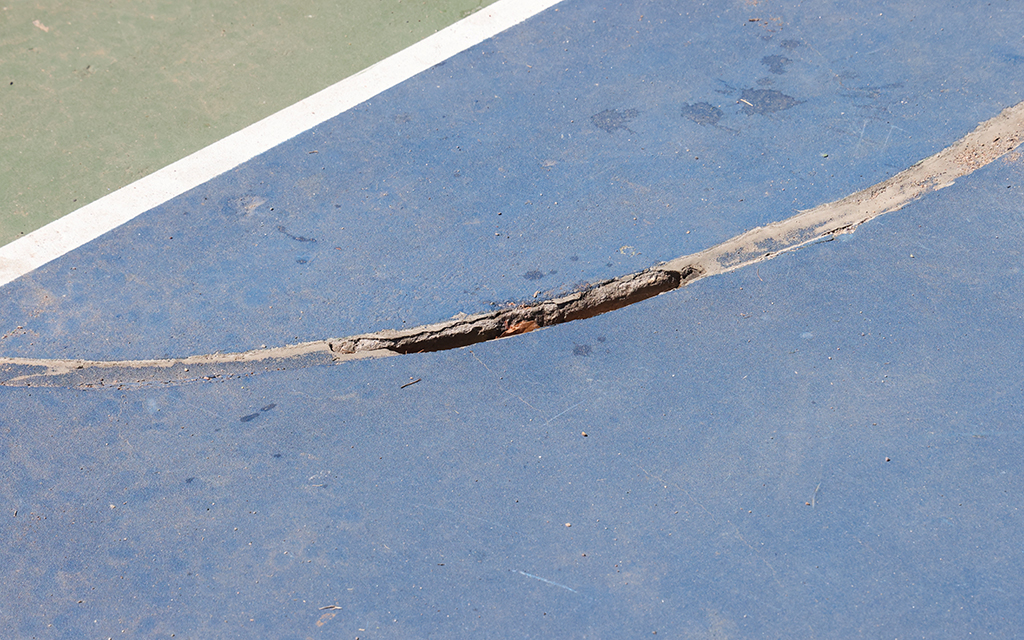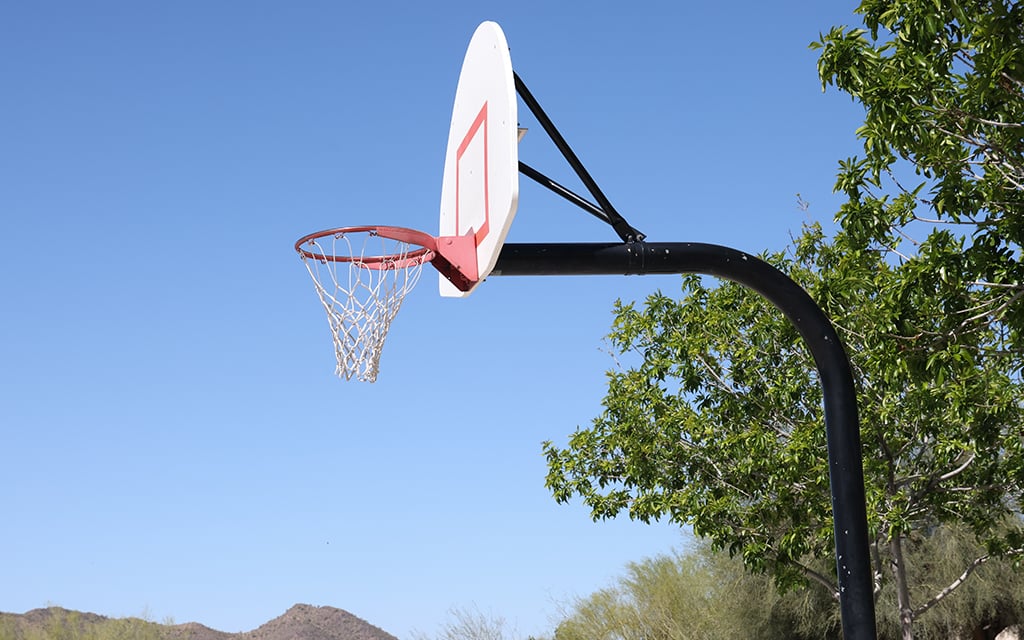
Sonoran Mountain Ranch Park in Peoria has three basketball hoops on its court and is nestled near the Eastwing Mountain Preserve trails. (Photo by Lauren Kobley/Cronkite News)
PEORIA – Three basketball hoops overlook the serene western vistas of Sonoran Mountain Ranch Park in northern Peoria. One faces a playset and has a double rim. The other two stand with rocks and grassy knolls beyond them. The surrounding mountains are tall, but not enough to block the sun from making the concrete simmer in the summer.
With constant play and the outdoor environment, basketball courts need plenty of maintenance. Some courts have cracks in their concrete or asphalt – some so long from the last resurfacing that weeds and dirt fill up portions of the court. Bulges due to the heat make them too bumpy for the ball.
Those are things that come with the weathering outdoor basketball courts face. Arizona’s harsh climate presents challenges that call for experienced services and unique measures to repair and resurface beaten-up outdoor courts.
City efforts to maintain courts

A deep crack in the surface of Moon Valley Park’s basketball court in Phoenix. (Photo by Lauren Kobley/Cronkite News)
The court at Sonoran Mountain Ranch Park is almost pristine compared to some in the Valley that have endured years of beating from the Arizona heat, thanks to the attention of the Peoria Parks and Recreation Department.
Mike Elliott, Peoria’s deputy director of Parks and Recreation, described the process the city uses to maintain its parks in the face of Arizona’s summers.
“We actually have a court assessment form, and we use it for basketball, tennis and pickleball courts — where we use four different factors that we score,” he said. Every six months, parks staff will look at surfacing, lighting, fencing and amenities related to the sport.
“We go out and we actually score based off of those four metrics … and then go out to assess what needs to happen,” he said.
Elliott said that in addition to court assessments, staff make regular checkups once a month, and resources are directed toward where they’re needed most.
Nearly 20 of Peoria’s three dozen neighborhood parks have basketball courts. Many are decades old – built between the 1980s and 2000s, when courts were considered a park standard.
The city hires third-party vendors to service tennis courts and resurface basketball courts.
“It’s really good, it’s really advantageous for the city just to leverage their expertise,” Elliott said. “Our courts are heavily used, they’re a very important asset in our city and in our department, so we really do focus on making sure we can maintain them as well as we can.”
If a court needed to be “completely redone,” he said, the city can use capital improvement funds granted by the city council for large-scale court improvements.
Sites within each park are chosen with care when a new court is built, Elliott said.
“Land consideration is probably the No. 1 thing; what’s the topography of the park? … We do have a couple of parks that we have started the planning process on,” Elliott said, noting the department aims to “make sure that it’s on flat land, make sure that we don’t have turf around the court so that moisture doesn’t get underneath the foundation and ruin it.
“Is it close to other court elements? Can you put it next to the pickleball court or tennis courts so they can share lighting?”
Elliott also mentioned that the land in northern Peoria, which is hillier, is more challenging to develop on. That part of the city has fewer basketball courts.
The area surrounding outdoor courts can be important as well in court placement, especially considering the extreme heat. Courts in parks may benefit from access to restrooms and shade to prevent heat-related illness, which is more likely for someone playing a vigorous, endurance-based sport like basketball.
Sunnyslope Park’s basketball court was the city’s most recent court project. Now available for play, the court uses post-tension concrete, which is expected to keep the foundation secure for at least 75 years.
“It’s going to be a standard for what we do going forward,” Elliott said.
The blazing heat of the blacktop

A basketball hoop at Palo Verde Park in Peoria. (Photo by Lauren Kobley/Cronkite News)
“Arizona is the toughest climate,” said Richard Garcia, owner of Mesa-based Out Play Sports Surfacing, which he started about six years ago. With over 25 years of experience in the sport-court industry, he knows well the challenges of court maintenance in Arizona.
The state’s harsh climate can make it hard to do outdoor concrete work, and in the summer, a court’s surface can be 40 or 50 degrees hotter than the surrounding air, according to Garcia.
“For the first 20 or 15 years of doing this, I traveled all over the United States, so going from the East Coast, where your highest temperature might be 80 or 90 in the summer, to out here, where in the summer it’s 115, 120, and the courts actually exceed 160 degrees.
“So out here, I’ve seen so many companies come out here and fail because it’s so extreme to do it,” Garcia said.
Garcia touted his company’s expertise dealing with “beat-up courts” but said asphalt courts can sometimes be beyond repair.
“Asphalt is the worst thing out here because it has oils in it and it dries out so fast,” Garcia said. “A majority of the asphalt courts are beyond repair and really need a lot of work to get them playable again. … Some of these courts we can’t even repair to even make playable anymore because they’re so bad off.”


